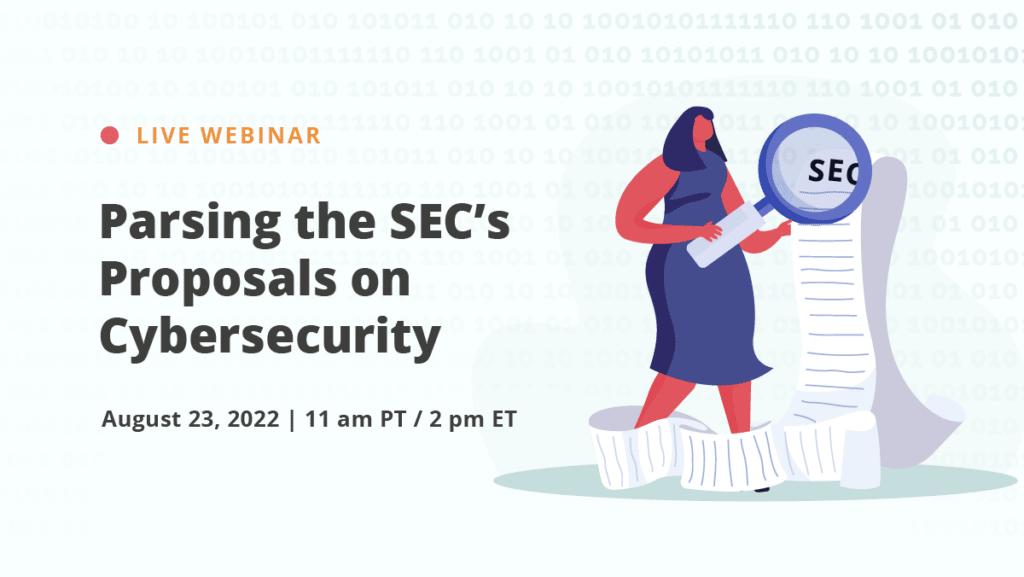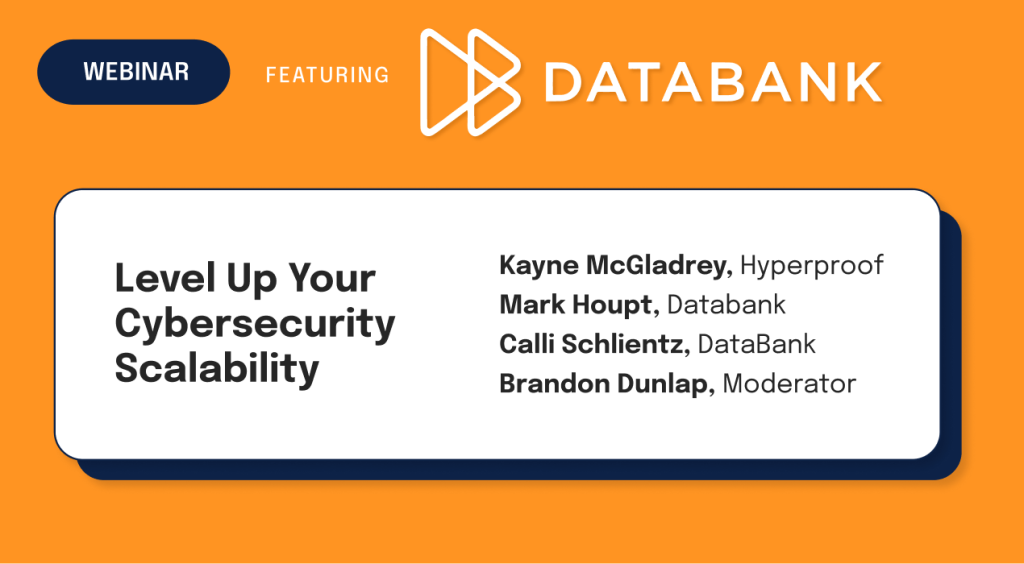The Ultimate Cybersecurity Checklist for Protecting Your Business

From startups to global enterprises, every organization is a potential cyberattack target in today’s interconnected business environment. According to Verizon’s 2024 Data Breach Report, in 2024, vulnerability exploitation experienced 180% growth vs 2023. Finding a comprehensive cybersecurity checklist to address these growing needs can feel like a daunting task.
The fallout of a cyber incident can be severe, whether it’s the direct financial loss from stolen data, legal fines due to compliance breaches, or the long-term damage to customer trust. Ransomware attacks, which accounted for nearly 24% of breaches, can now cost organizations between $1 and $2.25 million per incident, with the median cost per incident more than doubling in the last two years (Verizon).
Protecting your business against these threats is no longer optional — it’s essential. This cybersecurity checklist will help you assess your current defenses, close gaps, and build a solid foundation for safeguarding your business against the most frequently occurring cyber risks.
Cybersecurity checklist overview
The checklist outlined below addresses key areas of cybersecurity, including network security, data protection, access management, end-point protection, vendor risk management and incident response. Each section focuses on practical steps businesses can take to fortify their defenses. By following these guidelines, your company can minimize its vulnerability to cyberattacks, protect sensitive information, and stay compliant with relevant regulations.
1. Maintain network security
Network security is a foundational element of any robust cybersecurity program. A secure network ensures unauthorized users cannot access sensitive company resources, protecting against breaches and data theft.
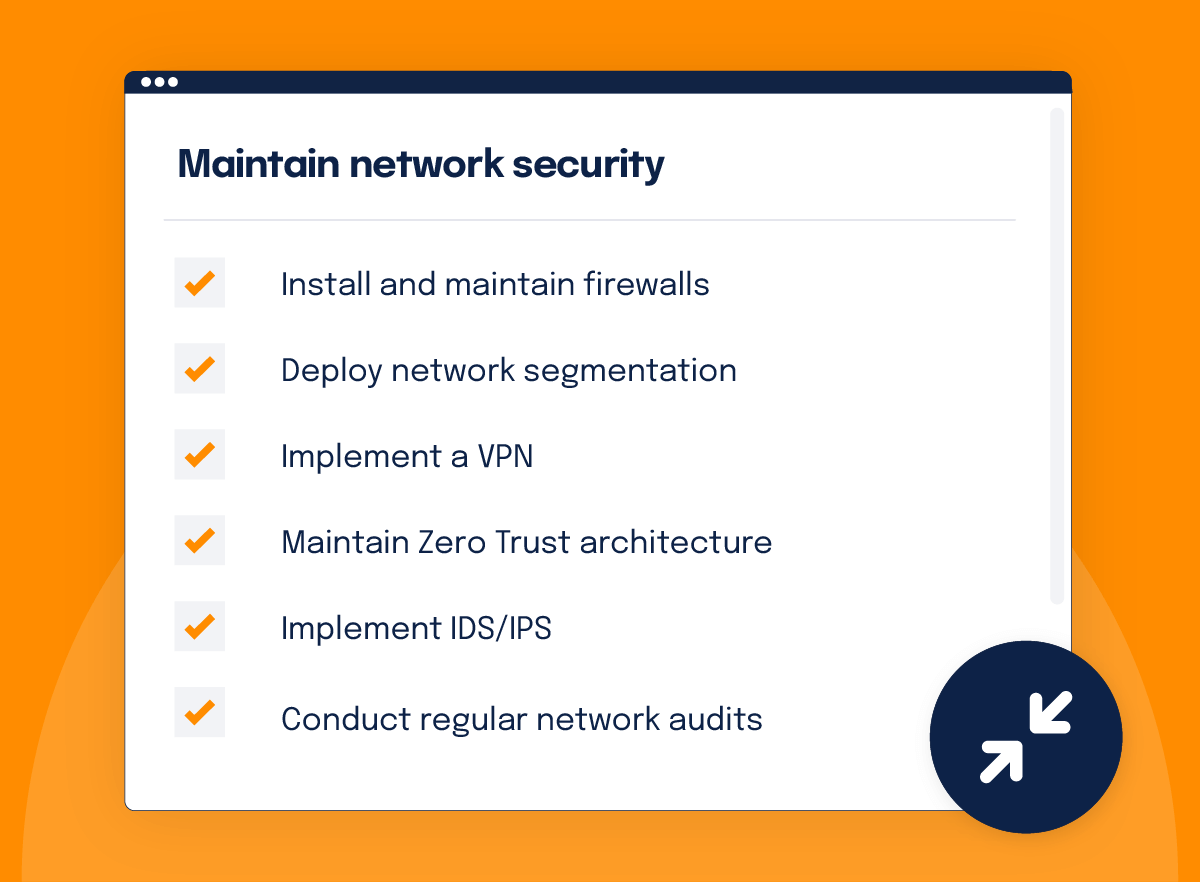
Install and maintain firewalls
Firewalls act as the first line of defense, filtering traffic to block unauthorized access. Firewalls must be configured correctly and updated regularly to address new threats. If employees are working from home, they should enable firewalls on their home networks for added protection.
Deploy network segmentation
Segmenting your network can limit the spread of a breach. Sensitive systems and data should be kept in a separate zone from less critical systems to minimize potential exposure.
Implement a virtual private network (VPN)
A VPN creates an encrypted tunnel for remote employees to access the company network securely. This ensures that data transmitted over public or less secure networks is protected. Using a VPN ensures that all data transmitted between the employee and the company’s network is encrypted, making it significantly harder for hackers to intercept or access sensitive information.
Maintain Zero Trust architecture
Many companies now conduct hybrid work. In a hybrid setup, zero trust assumes no network is secure. Every access request — whether from inside or outside the network — should be verified and authenticated to prevent unauthorized access.
Implement intrusion detection/prevention systems (IDS/IPS)
These systems monitor network traffic for suspicious activity. IDS/IPS can trigger alerts or take action to prevent breaches if any anomalies are detected. Even with firewalls and other perimeter defenses, attackers may still penetrate your network. IDS/IPS tools are designed to catch unusual behavior and flag potential threats before they cause significant damage, giving you a chance to act swiftly.
Conduct regular network audits
Network audits and vulnerability scans help identify potential weaknesses before cybercriminals can exploit them. These should be conducted periodically to ensure your defenses remain strong.
2. Minimize potential endpoint security threats
No cybersecurity checklist would be complete without including endpoint security threats. Endpoints like laptops, smartphones, and tablets are common targets for cyberattacks. Securing these devices ensures that they don’t become entry points for attackers.
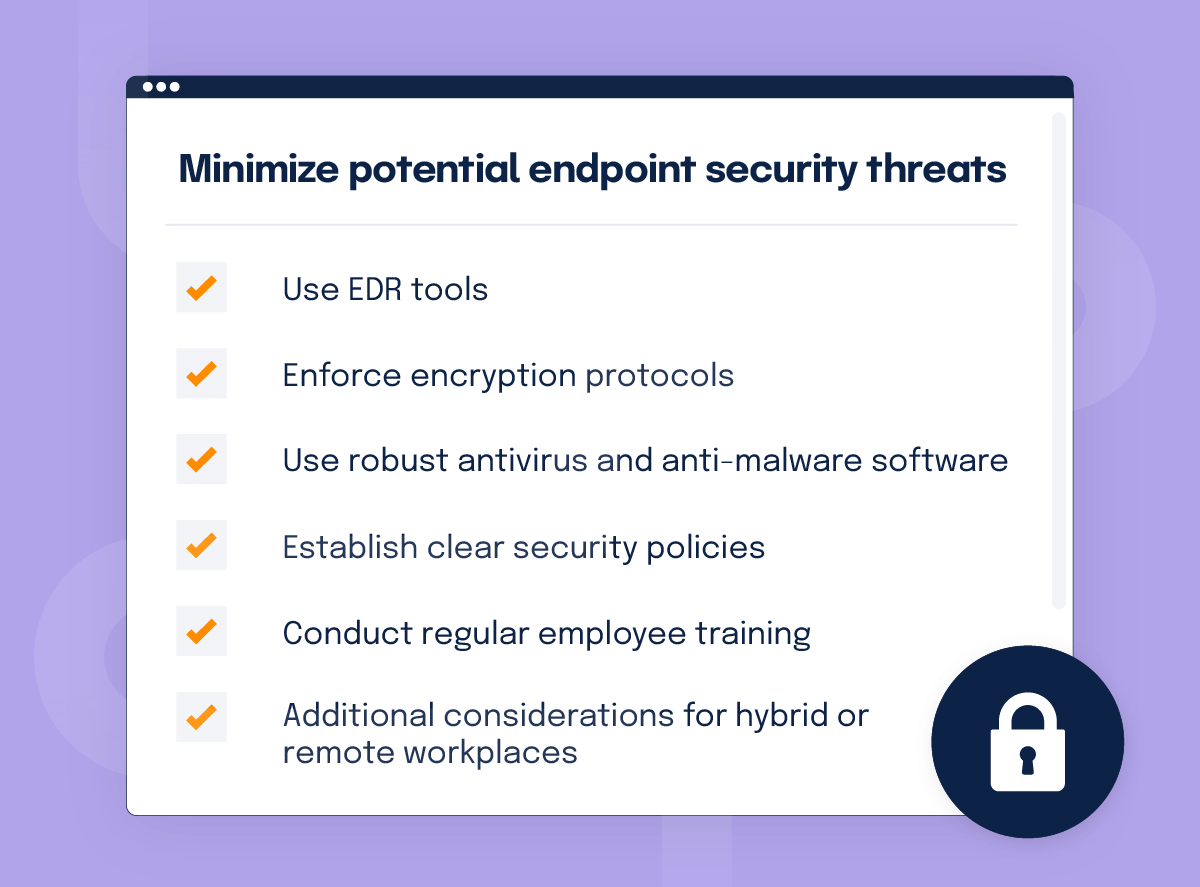
Use endpoint detection and response (EDR) tools
EDR solutions provide visibility into endpoint activities, allowing IT teams to detect and respond to threats before they cause harm.
Enforce encryption protocols
EDR solutions provide visibility into endpoint activities, allowing IT teams to detect and respond to threats before they cause harm.
Use robust antivirus and anti-malware software
Antivirus and anti-malware solutions are critical in defending against malicious software. Ensure that all devices are equipped with up-to-date protection.
Establish clear security policies
Employees play a significant role in maintaining endpoint security. To create a security-conscious culture, establish clear policies for device usage, such as securing devices when not in use, avoiding untrusted networks, and reporting lost or stolen devices immediately.
Conduct regular employee training
Policies are only as effective as those who follow them. Regular training sessions help staff understand how to use company-issued devices securely, recognize potential threats like phishing, and adhere to company policies. When employees and contractors are highly aware, the likelihood of devices being compromised is reduced.
Additional considerations for hybrid or remote workplaces
If you employ a hybrid or remote workforce, consider deploying cloud-based security solutions to manage and secure remote endpoints. Specific types of cloud-based security solutions include:
Cloud access security brokers
CASBs monitor and enforce security policies for data and applications stored in the cloud. They offer visibility into cloud service usage, detect potential risks, and prevent unauthorized access to cloud-based data, ensuring that employees accessing the cloud from various locations are doing so securely.
Secure Access Service Edge (SASE)
SASE combines networking and security functions delivered through the cloud. It ensures secure access to the company’s applications and data, regardless of an employee’s location, by integrating technologies like VPN, firewall, and zero-trust network access.
Endpoint protection platforms (EPP)
Cloud-based EPPs provide security for all endpoints — laptops, smartphones, and tablets — through a centralized platform. They offer antivirus, malware protection, and threat detection, and they can monitor and respond to security incidents across distributed devices in real-time.
Cloud-based identity and access management (IAM)
IAM solutions enable centralized management of user identities and permissions across cloud services. They support multi-factor authentication (MFA) and single sign-on (SSO), ensuring that only authorized users can access sensitive systems and data.
3. Establish robust data protection and backup processes
Data protection is critical to a cybersecurity checklist to avoid data breaches, ransomware attacks, or the loss of vital company information. Strong data protection policies ensure that data is secure at all times, both in storage and transit. Limiting the data you collect to only what is essential for business purposes is also a key aspect of reducing risk.
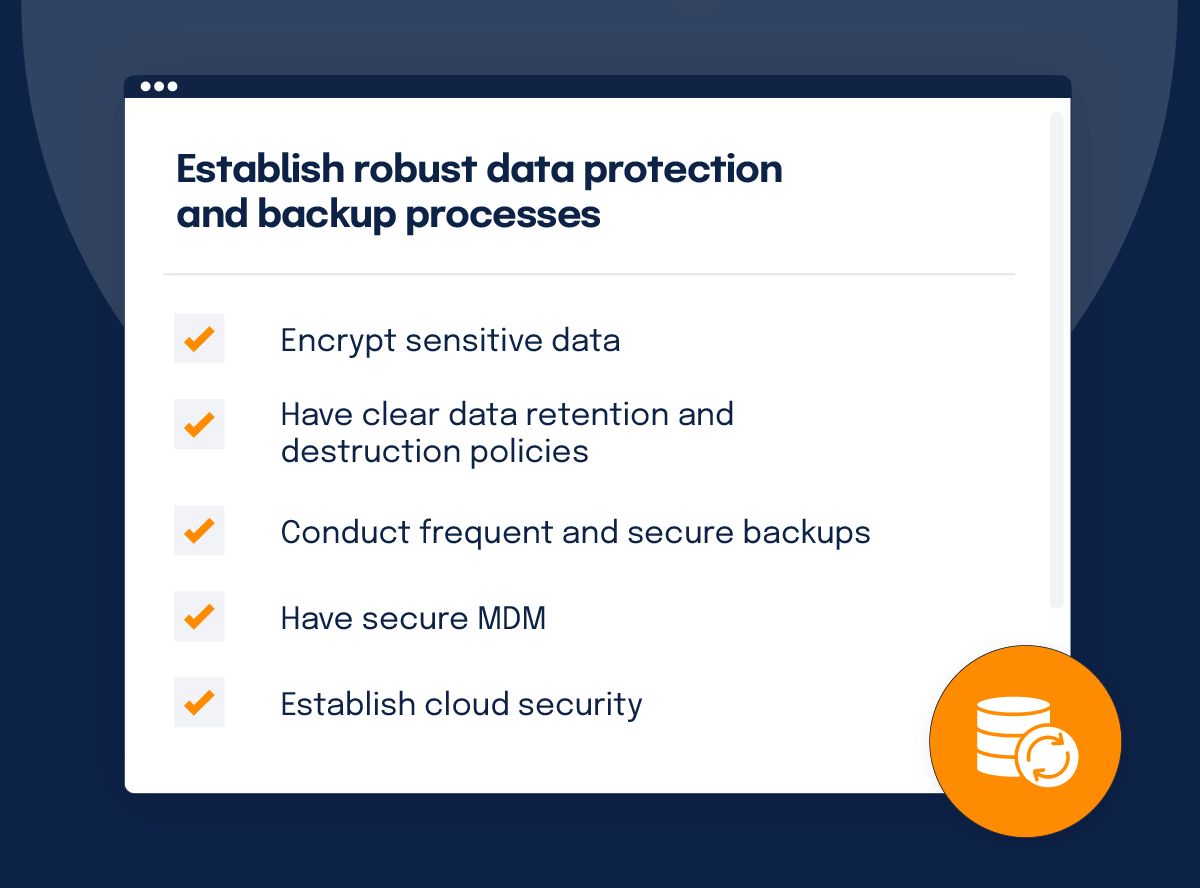
Encrypt sensitive data
Encryption should be applied to sensitive data both when it’s stored (at rest) and when it’s being transmitted. Regularly test your encryption protocols to ensure they’re functioning correctly.
Have clear data retention and destruction policies
Holding unnecessary sensitive data increases the risk of exposure. Define clear policies for retaining data only as long as needed and securely destroy it when it’s no longer required.
Conduct frequent and secure backups
Regular backups ensure your company can recover its data in case of a ransomware attack or system failure. Backups should be automatic, secure, and stored in multiple locations (e.g., cloud and on-premises).
Implement a secure mobile device management (MDM) solution
As more employees use personal devices for work, securing these devices is essential. MDM solutions help enforce security policies, such as remote wiping if a device is lost or stolen.
Establish cloud security
Ensure that cloud providers offer robust security controls, including encryption, access management, and regular data backups. Always vet providers to ensure they meet your security requirements.
4. Establish access control and authentication procedures
Adding access control authentication procedures to your cybersecurity checklist ensures that only authorized individuals access specific systems and data. Businesses can significantly reduce the risk of internal and external breaches by limiting access and using advanced authentication methods.
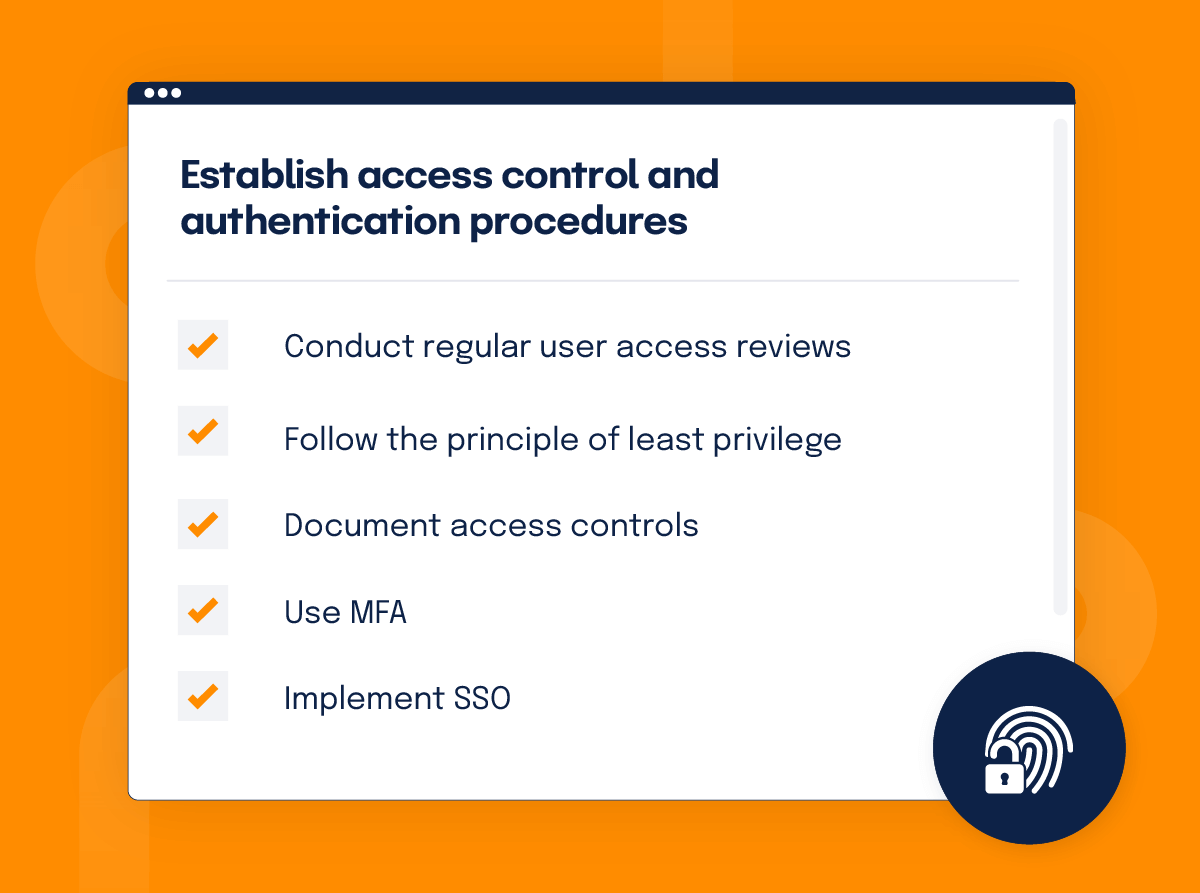
Conduct regular user access reviews
Regularly reviewing who has access to what ensures that only the right people can access sensitive information. This also helps identify any unnecessary or outdated access permissions.
Follow the principle of least privilege
This principle states that users should only have the minimum level of access necessary to perform their job. Applying this principle reduces the chances of insider threats or accidental breaches.
Document access controls
Documenting access controls is critical for maintaining accountability and ensuring that security policies are consistently applied. Formalizing these controls into official company policies ensures clarity around who has access to which systems and why, helping to prevent unauthorized access and aiding in compliance with regulatory requirements.
Use multi-factor authentication (MFA)
Implement MFA on all of your systems. MFA provides an extra layer of security by requiring users to provide two or more forms of verification before accessing a system. This dramatically reduces the risk of unauthorized access.
Implement single sign-on (SSO)
SSO simplifies access management by allowing users to log in to multiple systems with a single set of credentials. This improves user experience and makes it easier to manage and secure access.
Is your user access review process too tedious?
5. Develop and test a comprehensive incident response plan
The human element continues to be the front door for cyber criminals. Verizon’s 2024 Data Breach Report — which surveyed 8,000+ security incidents globally — found that 68% of all breaches involve a non-malicious human action, which refers to a person making an error or falling prey to a social engineering attack.
This stat illustrates how difficult it is to prevent breaches. We included a well-thought-out incident response plan in our cybersecurity checklist to ensure that your team can respond quickly and effectively when an attack occurs, minimizing damage and downtime. A strong, comprehensive incident response plan includes:
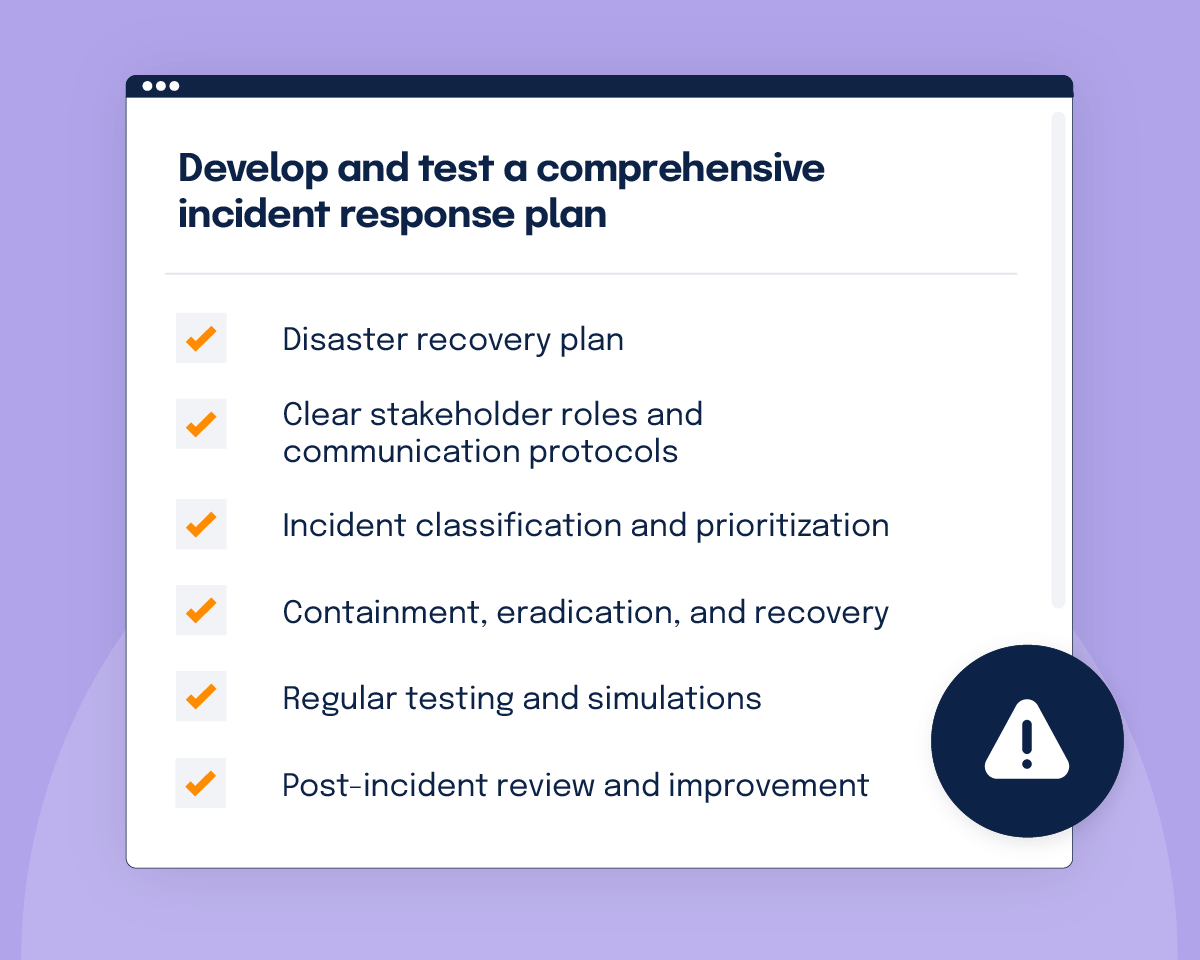
Disaster recovery plan (DRP)
A DRP outlines how your business will continue to operate after a cyberattack or other catastrophic event. It should include detailed steps for restoring critical systems, data, and operations. To ensure continuity, regularly update your DRP to reflect new technologies or changes in operations.
Clear stakeholder roles and communication protocols
Every minute counts during a breach. Ensure all stakeholders—from IT to legal to executive teams—know their roles and responsibilities to contain the breach swiftly. Establish clear internal communication protocols to coordinate the response and external protocols to inform customers, partners, and regulators as necessary. Having pre-drafted communications can help prevent confusion during a crisis.
Incident classification and prioritization
Not all security incidents are equally urgent. Your plan should include guidelines for classifying incidents by severity and prioritizing responses based on potential impact. This ensures that the most critical incidents are addressed immediately.
Containment, eradication, and recovery
Define how to contain the breach, eradicate the threat, and recover systems. Include detailed steps for each phase and the tools and personnel required to execute them.
Regular testing and simulations
Periodically test your incident response plan through simulated attacks, such as tabletop exercises or penetration tests. This helps identify weaknesses and familiarizes your team with their roles under pressure. Post-test reviews are crucial for refining the plan and ensuring readiness.
Post-incident review and improvement
Conduct a full review of the response after any incident to identify gaps or inefficiencies. Document lessons learned, adjust the plan accordingly, and implement improvements to strengthen your future defenses.
6. Implement cybersecurity compliance frameworks
Compliance frameworks are an essential part of a cybersecurity checklist. They provide structured approaches to managing and securing data, protecting a company’s IP, maintaining users’ privacy, and helping your organization stay compliant. These frameworks help organizations establish data protection, risk assessment, and incident response processes. They also help your business demonstrate that it takes cybersecurity seriously.
Choosing the right cybersecurity compliance framework for your organization is about finding one that is practical for your company stage, meets the requirements and expectations of your customer base, is aligned with your business’s operational complexity, and adheres to the regulations and rules governing your industry.

Common frameworks include SOC 2®, ISO 27001, NIST CSF, and NIST SP 800-53. Choosing the right compliance framework requires an internal assessment and understanding of the key differences between various frameworks.
In addition to implementing compliance frameworks, conducting regular audits will help ensure your company meets its security and compliance requirements. Software platforms like Hyperproof can automate much of the audit (including the control testing process) to reduce the burden on your staff.
7. Ensure your organization has integrated risk management
Including integrated risk management (IRM) in your cybersecurity checklist centralizes how your organization identifies, assesses, and manages risks, improving decision-making, communication, and response times across departments. With IRM, risks are tracked and prioritized in one place, enabling faster action on emerging threats and ensuring that security controls align with business objectives. It also streamlines compliance efforts and audit readiness, making demonstrating adherence to regulatory standards easier. Here are practical steps to take to develop a holistic risk management program:
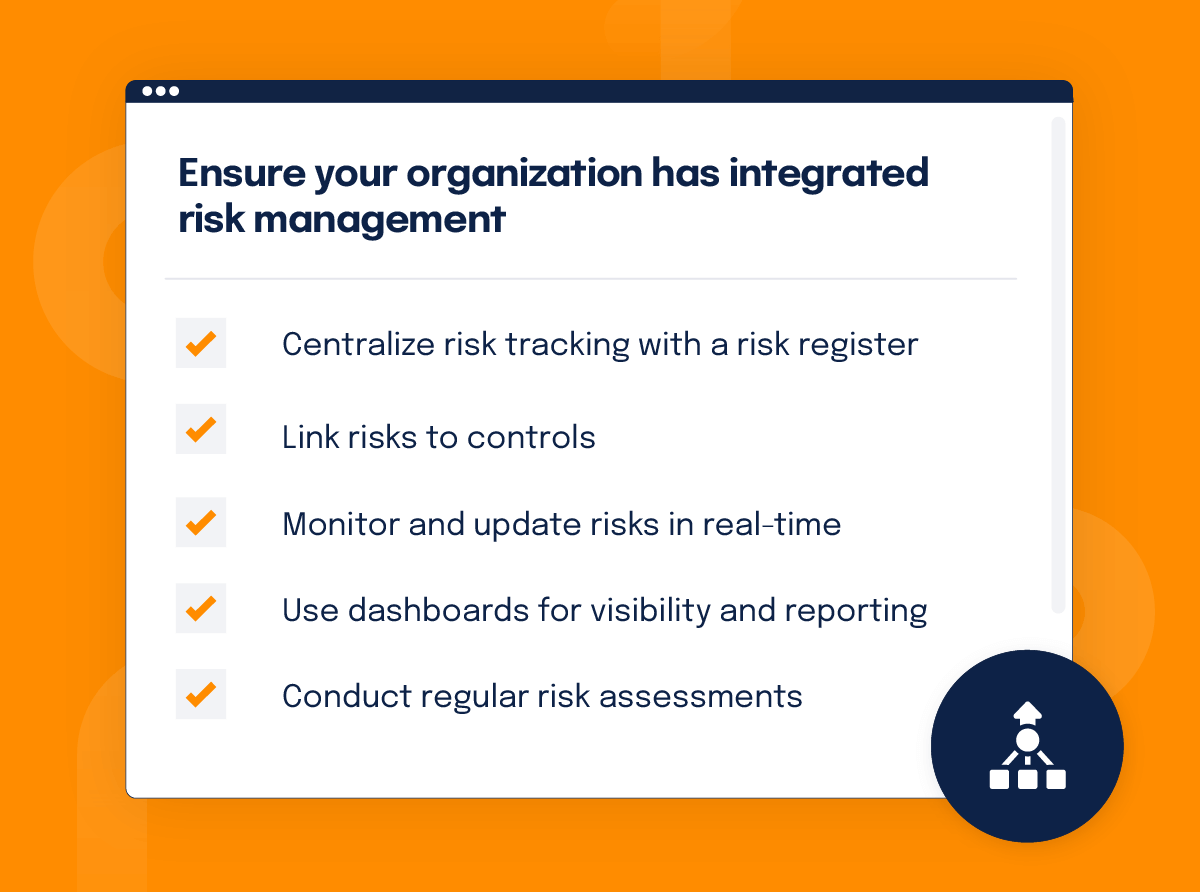
Centralize risk tracking with a risk register
Implement a risk register to log and assess all organizational risks. This provides a unified view of risks across departments, ensuring that everyone from IT to leadership understands the risk landscape and priorities. Use standardized scoring for each risk’s likelihood and impact to evaluate their severity consistently.
Link risks to controls
Map identified risks to your current security controls to ensure mitigation measures are in place. For instance, a risk involving sensitive data exposure should be linked to controls about how you handle encryption, access controls, and monitor for data exfiltration. This helps you quickly identify gaps where additional controls may be needed.
Monitor and update risks in real-time
Regularly review and update the risk register to account for new vulnerabilities, such as those caused by system updates or evolving cyber threats. Continuous monitoring helps your team respond swiftly, minimizing the impact of incidents.
Use dashboards for visibility and reporting
Leverage real-time dashboards to visualize risk levels and the effectiveness of mitigation efforts. These reports offer clear insights for leadership, ensuring alignment on the most pressing risks and the actions to address them.
Conduct regular risk assessments
Schedule periodic assessments to evaluate new risks and adjust mitigation strategies. These assessments ensure that your risk management approach evolves in response to changing business needs and threat landscapes.
8. Implement adaptive control testing
Adaptive control testing is an integral part of maintaining a strong cybersecurity posture, and thus, an important part of your cybersecurity checklist. Organizations can automate control testing by leveraging a SaaS platform such as Hyperproof, ensuring that controls remain effective and compliant with internal and external requirements.

Automate control workflows
A SaaS platform enables organizations to automate workflows that test control validity, hold control owners accountable, and remediate issues promptly. This level of automation reduces manual efforts, making it easier to maintain adequate security controls without overburdening your team. Automation also ensures that tests are conducted regularly and consistently across the organization so there’s no gap in control validation.
Test and monitor control effectiveness
SaaS platforms can automatically test and monitor control effectiveness, creating tasks based on test status. If a control fails, the system can immediately trigger a notification or remediation task, addressing issues promptly to reduce risk exposure. Continuous monitoring helps identify weaknesses before they lead to significant problems, keeping your security controls strong and up to date.
Use no-code automation for efficiency
No-code automation workflows allow operators to design efficient, repeatable processes that scale as your business grows. This empowers non-technical teams to set up and manage automated testing and reporting without needing in-depth coding skills, thereby increasing efficiency across the board. Automating these processes ensures that controls are continuously tested and failed tests are resolved quickly, maintaining a proactive approach to cybersecurity risk management.
9. Regularly assess the security practices of your vendor
Vendor risk management is a critical but often overlooked component of a comprehensive cybersecurity checklist. The security practices of third-party vendors—especially those handling sensitive data in HR, accounting, payroll, or sales—can directly impact your organization’s security posture. As businesses increasingly rely on external vendors for various services, conducting vendor assessments is essential to ensure their security measures align with your standards. Failing to do so could expose your company to vulnerabilities and compliance issues.
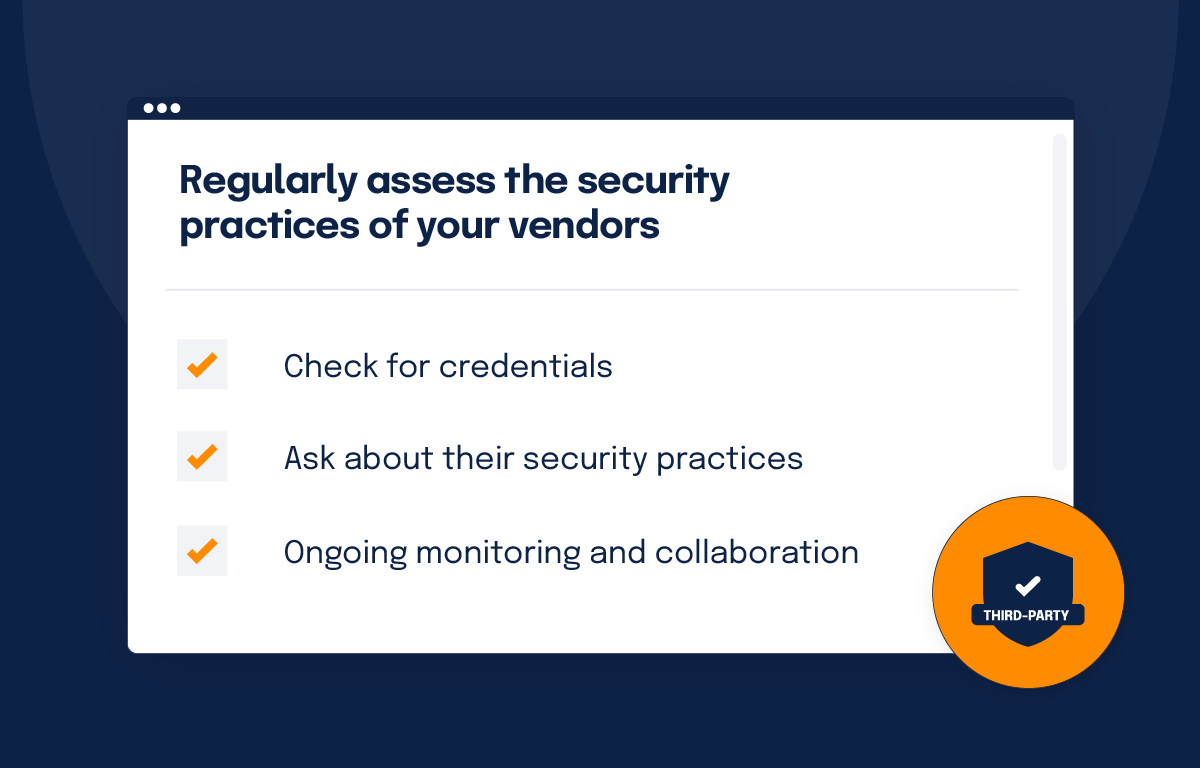
Check for credentials
When selecting a new software platform or outsourcing any business functions, always check which compliance certificates the vendor has earned and frameworks the vendor follows. Depending on your industry, look for standards such as ISO 27001, SOC 2®, or GDPR compliance. Additionally, periodically assess existing vendors to ensure their security practices continue to meet your company’s evolving requirements. Identify gaps in their protocols, such as inadequate encryption or poor access controls, and work with vendors to mitigate risks.
Ask about their security practices
Ask your vendor tailored security questions focusing on key risk areas relevant to your business, such as data protection, encryption, and access management. You can streamline this process with security questionnaire automation tools, tracking vendor responses and flagging incomplete or concerning results, allowing your team to follow up quickly and address potential risks before they escalate.
Ongoing monitoring and collaboration
Vendor risk management shouldn’t be a one-time exercise. Continuously monitor your riskiest vendors for changes in their security posture, such as breaches, changes in compliance status, or shifts in their data-handling practices. Establish a collaborative relationship with key vendors, where security improvements and audits are part of the regular business dialogue. This proactive approach ensures that both parties are aligned in maintaining robust security defenses.
10. Get appropriate cyber insurance coverage
Given the frequency of data breaches and the fact that data privacy laws have increased businesses’ responsibility for protecting customer data, cyber insurance is a must in today’s business environment. It’s essential to add this to your cybersecurity checklist. Some of the most common elements in a comprehensive cyber insurance policy include:
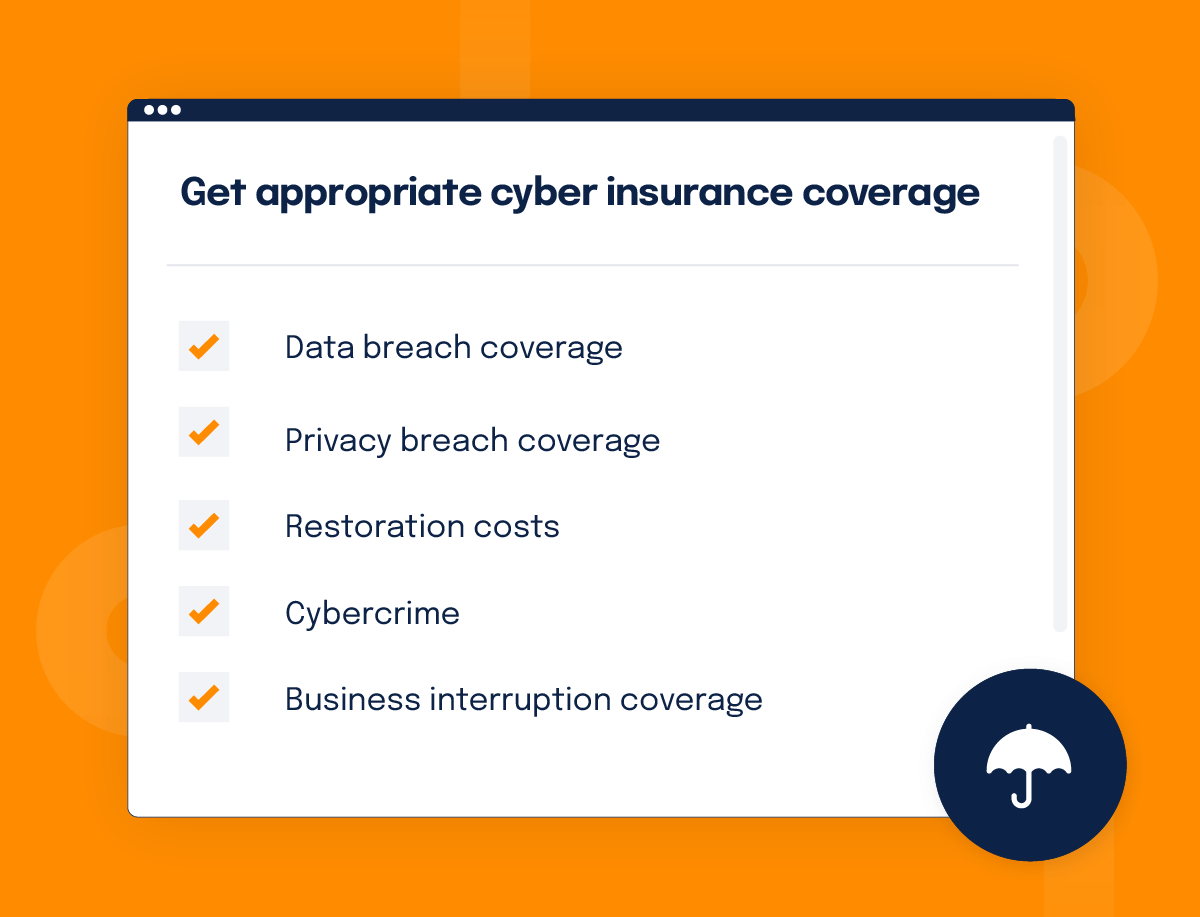
- Data breach coverage
- Privacy breach coverage
- Restoration costs
- Cybercrime
- Business interruption coverage
These coverages are designed to help companies in the event of a hacker gaining access to their systems or a data or privacy breach. Breach response and restoration cost coverages assist companies by covering the costs of identifying the source of the breach and making public-facing announcements, as well as helping with legal fees and other third-party costs.
Business interruption insurance, whether related to your network or through cloud service providers, can also help you recover lost income if a breach or attack causes a shutdown or interruption in your company’s networks.
Standard cyber insurance packages will often cover the following:
- Identity theft: Individual or class-action allegations
- Forensic analysis: Cost of forensic analysis, ransom payments and settlements
- Breach of systems: On your company’s computers or systems, including customer notification and credit monitoring
- Misrepresentation: Hack or breach on a client, partner, or vendor system when you’re the host of their data
Some policies will also cover damages resulting from electronic funds transfer (scammers tricking employees into transferring funds to a malicious third party) and social engineering (fraudsters posing as friends to trick people into sensitive information).
Others even include protection against cybercrimes involving the theft of financial information or securities. These can be valuable coverages in a policy if a breach exposes your company to financial liabilities.
Cyber insurance policies typically offer two main types of coverage:
- First-party coverage: This covers the direct financial losses your business incurs from a cyber incident, including costs for data recovery, business interruption, and incident response.
- Third-party coverage: This helps if a cyberattack affects your customers, covering legal fees, settlements, and damages. For instance, third-party coverage would cover lawsuits or regulatory fines if a breach exposes customer data.
Choosing the right cyber insurance policy means examining the policy limits — how much it will pay out—and any exclusions. Large enterprises often won’t do business with you unless your third-party coverage policy’s limit is high enough.
To determine how much coverage is right for your organization, conduct an internal evaluation of how much customer information your company stores and what types of information are being stored. For instance, first names and email addresses are much less sensitive than social security numbers and bank accounts. Further, assessing the worst-case scenarios around downtime and the recovery period is a prudent step when considering business interruption coverage.
Common exclusions may include pre-existing vulnerabilities or incidents stemming from negligence, like failing to install security updates. Be sure to check the list of exclusions before purchasing a policy.
Cybersecurity is an ongoing process
Cybersecurity is a continuous journey, not a one-and-done activity. As your business evolves, so do the threats it faces. This cybersecurity checklist gives you practical steps to strengthen your defenses, but reviewing and adapting your approach regularly is equally important. By actively prioritizing security, you’re not just mitigating risks, you’re choosing to safeguard your customers’ trust and the integrity of your operations.
Investing in cybersecurity today ensures your company’s ability to adapt and grow tomorrow.
See Hyperproof in Action
Related Resources
Ready to see
Hyperproof in action?






